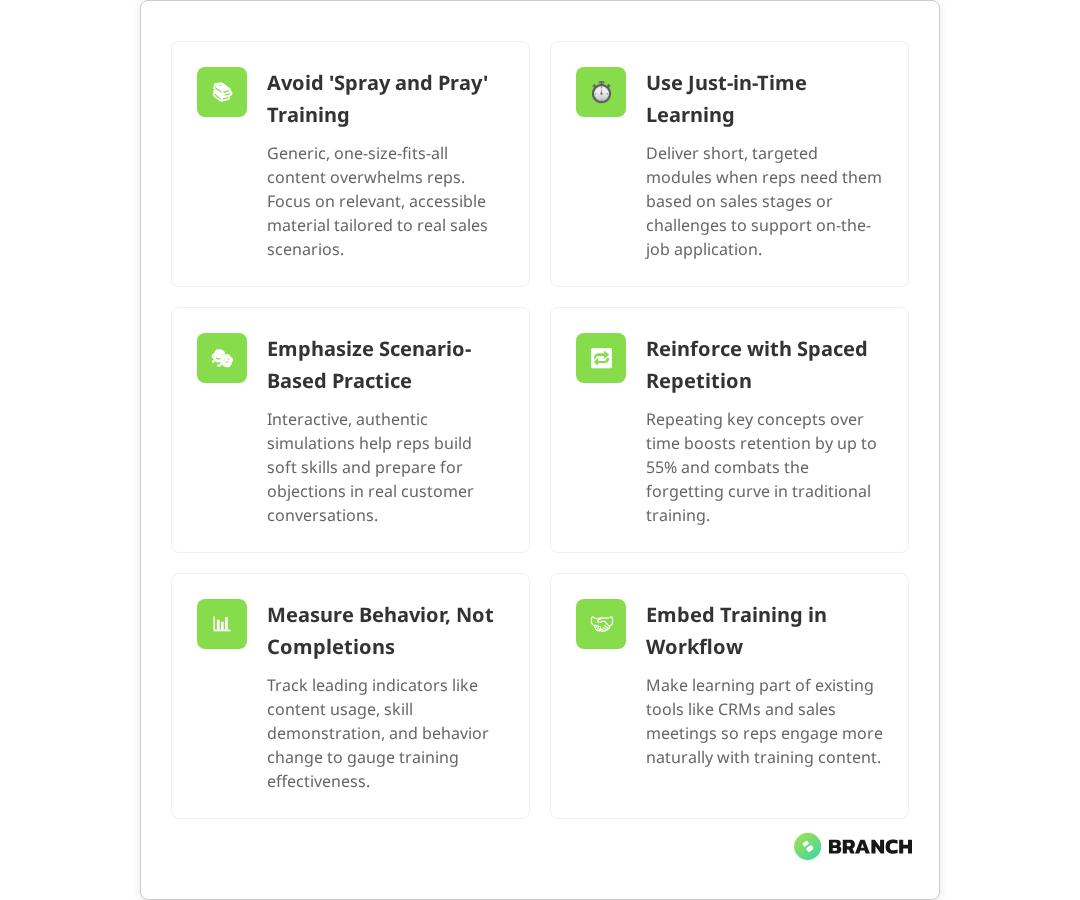Sales teams today face an increasingly complex landscape: longer sales cycles, more decision-makers in the buying process, and customers who arrive already 60% through their research journey before engaging with sales representatives. Yet many organizations approach sales enablement training like it’s still 1995—generic presentations, one-size-fits-all content, and crossed fingers that something will stick.
The reality is that effective sales enablement training isn’t about cramming product features into your reps’ heads or running them through the same role-play scenarios every quarter. It’s about creating a strategic learning system that bridges the gap between what your sales team knows and what they need to close more deals, faster.
If you’re a sales leader, L&D professional, or operations executive wondering why your current training programs aren’t moving the needle on revenue, this article will help you understand what actually works—and why most sales training falls short.
Why Most Sales Enablement Training Misses the Mark
Before diving into what makes training effective, let’s acknowledge the elephant in the room: most sales enablement programs are built on shaky foundations. They suffer from three critical flaws that undermine their impact from day one.
The “Spray and Pray” Content Problem
Too many organizations treat sales enablement like a content dumping ground. Research shows that this approach creates significant problems: 72% of sales leaders agree that training fails when it tries to be one-size-fits-all, and reps struggle to find relevant materials when they actually need them during customer calls. The issue isn’t volume—it’s relevance and accessibility.
Effective sales enablement training starts with understanding that less is more. Your reps need the right information at the right moment, not every piece of information your marketing team has ever produced.
One-and-Done Training Events
The traditional approach of bringing the sales team together for a quarterly training session might feel productive, but it’s pedagogically flawed. Research consistently shows that people forget 70% of new information within 24 hours without reinforcement, and 84% of training content is forgotten within three months without relevance and repetition. Yet most sales training programs are designed like academic lectures rather than skill-building systems.
Disconnection from Real Sales Situations
Here’s where many training programs really fall apart: they’re built by people who haven’t carried a quota in years (if ever) and don’t reflect the messy reality of modern sales conversations. Research indicates that 21-31% of sales leaders report that real-life scenarios and soft skills are missing from their training programs. Your reps need to handle objections about budget, navigate complex procurement processes, and articulate value to technical buyers—not just recite product features.

The Architecture of Effective Sales Enablement Training
Effective sales enablement training isn’t a single program—it’s an interconnected system that supports reps throughout their entire sales cycle. Multiple studies confirm that the most successful programs integrate ongoing training, content, coaching, and tools to ensure representatives have the right knowledge and resources at each step of the sales process.
Just-in-Time Learning Modules
The best sales enablement platforms deliver bite-sized learning exactly when reps need it. Research from leading sales enablement platforms shows that just-in-time learning reduces ramp-up time and supports real-time decision making by providing contextual, relevant content in the flow of work. Instead of front-loading everything in onboarding, they provide targeted modules that align with specific sales stages or customer types.
For example, when a rep logs an opportunity as “demo scheduled,” the system might surface a 5-minute module on discovery questions specific to that industry, or a quick refresher on the most compelling ROI calculations for similar-sized deals.
Scenario-Based Practice Environments
Effective training creates safe spaces for reps to practice difficult conversations before they happen in real life. This goes beyond basic role-playing to include interactive scenarios that branch based on the rep’s responses, mimicking the unpredictable nature of actual sales calls.
The key is authenticity—scenarios should be based on real objections, real competitive situations, and real customer personas that your team encounters regularly.
Reinforcement and Spaced Repetition
The most successful sales enablement programs borrow from cognitive science research on memory retention. Studies show that spaced repetition can improve sales skills retention by up to 30-55% by moving knowledge into long-term memory and countering the forgetting curve. They use spaced repetition to ensure critical concepts stick, and they provide multiple touchpoints for the same information across different formats and contexts.
| Learning Method | Retention Rate | Best Use Case | Implementation Complexity |
|---|---|---|---|
| Traditional presentation | 10% | Broad overviews | Low |
| Interactive scenarios | 65% | Skill practice | Medium |
| Spaced repetition + practice | 85% | Critical processes | High |
| Peer coaching + feedback | 90% | Advanced skills | Medium |
What the research says
- Studies consistently show that traditional presentations have retention rates of only about 10% after one week, highlighting the need for more engaging training methods.
- Interactive, scenario-based learning methods show significantly higher engagement and retention rates compared to passive training approaches, though early research suggests effectiveness varies by implementation.
- Spaced repetition and reinforcement techniques can improve knowledge retention by 30-55% by helping sales reps internalize critical concepts and apply them consistently in real situations.
- Just-in-time learning delivery has been shown to reduce ramp-up time and improve real-time decision making, but we need more research on optimal timing and content formats.
- Training programs that focus on customer-centric messaging and practical sales processes tend to correlate more strongly with improved deal velocity and win rates than product-focused training alone.
Content That Actually Moves the Revenue Needle
Not all sales training content is created equal. The most effective programs focus their efforts on the specific knowledge and skills that correlate with deal velocity and win rates, with research showing that targeted training aligned to key sales outcomes has greater impact on revenue performance.
Customer-Centric Messaging Frameworks
Instead of product-focused training that lists features and benefits, effective programs teach reps how to have customer-centric conversations. This means understanding buyer personas at a granular level: their pain points, their decision-making process, and the language they use to describe their challenges.
The best training programs include:
- Industry-specific talk tracks that resonate with different buyer types
- Value proposition frameworks that connect features to business outcomes
- Objection handling that addresses real concerns, not theoretical ones
- Competitive differentiators that matter to customers, not just to your marketing team
Process Excellence Over Product Knowledge
Here’s a counterintuitive truth: most sales reps already know enough about your products to sell them effectively. What they struggle with is process—how to qualify opportunities, when to involve technical resources, how to navigate complex buying committees.
Effective sales enablement training spends more time on methodology than on product features. It teaches reps how to:
- Qualify opportunities using consistent criteria
- Map and influence buying committees
- Structure discovery conversations that uncover real business impact
- Create urgency without being pushy
- Handle pricing conversations with confidence
Tools and Technology Integration
Modern sales teams use dozens of tools—CRM systems, sales engagement platforms, conversation intelligence software, and more. Yet many training programs treat technology as an afterthought, resulting in low adoption and inconsistent data.
Effective programs embed tool training into the sales process itself, showing reps not just how to use the technology, but when and why to use it for maximum impact.
Read more about connecting training effectiveness to actual performance outcomes.Measuring What Matters: Beyond Completion Rates
The biggest mistake organizations make with sales enablement training is measuring the wrong things. Completion rates and satisfaction scores might make stakeholders feel good, but they don’t predict revenue impact.
Leading Indicators of Training Success
Effective sales enablement programs track metrics that actually correlate with business outcomes:
- Behavior change: Are reps actually applying what they’ve learned in real sales situations?
- Content usage: Which training materials do top performers use most often?
- Skill demonstration: Can reps successfully handle scenarios in practice environments?
- Time to productivity: How quickly do new reps reach full quota performance?
Connecting Training to Revenue Outcomes
The gold standard for sales enablement measurement is demonstrating a clear connection between training participation and revenue results. This requires:
- Baseline performance data before training implementation
- Control groups to isolate training impact from other variables
- Long-term tracking to account for sales cycle length
- Segmentation by role, experience level, and territory characteristics
Organizations that invest in robust measurement often discover that their most effective training programs aren’t the ones that feel most comprehensive, but the ones that create the most behavioral change among their reps.
Building vs. Buying: Your Strategic Options
When it comes to sales enablement training, organizations typically face three paths: build it internally, buy an off-the-shelf solution, or partner with a specialist team to create something custom. Each approach has trade-offs that depend on your specific situation.
Internal Development
Building sales enablement training internally works best when you have strong L&D resources and your sales process is relatively unique. The main advantages are control and customization—you can create exactly what your team needs without compromise.
However, internal development often underestimates the complexity of creating effective learning experiences. It’s not enough to have subject matter expertise; you also need instructional design skills, technology capabilities, and the bandwidth to iterate based on feedback.
Off-the-Shelf Solutions
Generic sales training programs can provide a foundation, especially for fundamental skills like discovery questioning or objection handling. They’re typically less expensive and faster to implement than custom solutions.
The downside is that they can’t address your specific products, markets, or competitive landscape. They also tend to focus on theoretical knowledge rather than applied skills in your particular sales environment.
Custom Development Partnership
Working with a specialist team to create custom sales enablement training offers the best of both worlds: professional instructional design expertise combined with content that’s tailored to your specific business needs.
This approach works particularly well for organizations that have unique value propositions, complex sales processes, or specialized industry requirements that off-the-shelf solutions can’t address.
Implementation: Getting Your Team to Actually Use the Training
Even the most well-designed sales enablement training will fail if your team doesn’t engage with it consistently. Implementation success comes down to change management, not just content quality.
Leadership Modeling and Reinforcement
Sales managers are the linchpin of successful training adoption. When managers actively reference training content in team meetings, coaching sessions, and deal reviews, reps understand that the training actually matters to their success.
The most effective implementations include manager enablement alongside rep training, ensuring that front-line leaders know how to reinforce and apply the concepts in their day-to-day management activities.
Integration with Existing Workflows
Training that exists in isolation rarely gets used consistently. The most successful programs integrate learning opportunities directly into the tools and processes reps already use—CRM systems, sales meetings, and pipeline reviews.
For example, instead of requiring reps to log into a separate learning platform, effective programs might surface relevant training modules directly in the CRM when reps update opportunity stages or encounter specific deal scenarios.
Peer-to-Peer Learning and Collaboration
Your top performers are often your best teachers. Effective sales enablement programs create structured ways for successful reps to share their approaches, whether through recorded call reviews, peer coaching sessions, or collaborative content creation.
This approach not only improves training quality but also increases buy-in, since the content comes from respected colleagues rather than corporate headquarters.
When to Partner with Sales Enablement Specialists
Creating effective sales enablement training requires a unique combination of skills: instructional design expertise, sales methodology knowledge, technology implementation capabilities, and change management experience. Most organizations don’t have all of these competencies in-house.
Consider partnering with specialists when you’re facing:
- Complex sales processes: Multi-stakeholder deals, long sales cycles, or technical products that require sophisticated training approaches
- Rapid growth: Scaling challenges where you need to onboard new reps quickly while maintaining quality
- Performance gaps: Persistent issues with quota attainment, deal velocity, or competitive win rates
- Technology integration: Requirements for custom learning platforms or integration with existing sales and marketing tools
A team like Branch Boston brings together strategy, design, and engineering capabilities to create learning experiences that are both pedagogically sound and technically robust. We understand that effective sales enablement isn’t just about content creation—it’s about building systems that drive sustainable behavior change.
The key is finding a partner who takes the time to understand your specific sales challenges, buyer journey, and organizational culture before proposing solutions. Cookie-cutter approaches rarely work in sales enablement, where context and customization are critical to success.
FAQ
How long does it take to see results from sales enablement training?
Most organizations see initial behavioral changes within 30-60 days, but meaningful revenue impact typically takes 3-6 months due to sales cycle length. Leading indicators like content usage and skill demonstration appear much sooner, often within weeks of implementation.
What's the biggest mistake organizations make with sales enablement training?
The most common mistake is treating training as a one-time event rather than an ongoing system. Organizations often invest heavily in initial content creation but fail to plan for reinforcement, updates, and continuous improvement based on feedback and results.
Should we focus on product training or sales skills training first?
In most cases, sales process and methodology training delivers faster ROI than product training. Reps typically already know enough about your products to sell effectively—what they struggle with is qualifying opportunities, handling objections, and navigating complex buying processes.
How do we measure the ROI of sales enablement training?
The most effective approach combines leading indicators (behavior change, content usage, skill demonstration) with lagging indicators (quota attainment, deal velocity, win rates). Establish baseline metrics before training implementation and track changes over time, accounting for sales cycle length and other variables.
What technology infrastructure do we need for effective sales enablement training?
The minimum viable technology stack includes a learning management system that integrates with your CRM, content management capabilities, and basic analytics. More advanced implementations might include video-based coaching platforms, simulation environments, and AI-powered content recommendations, but start simple and build based on actual usage patterns.




